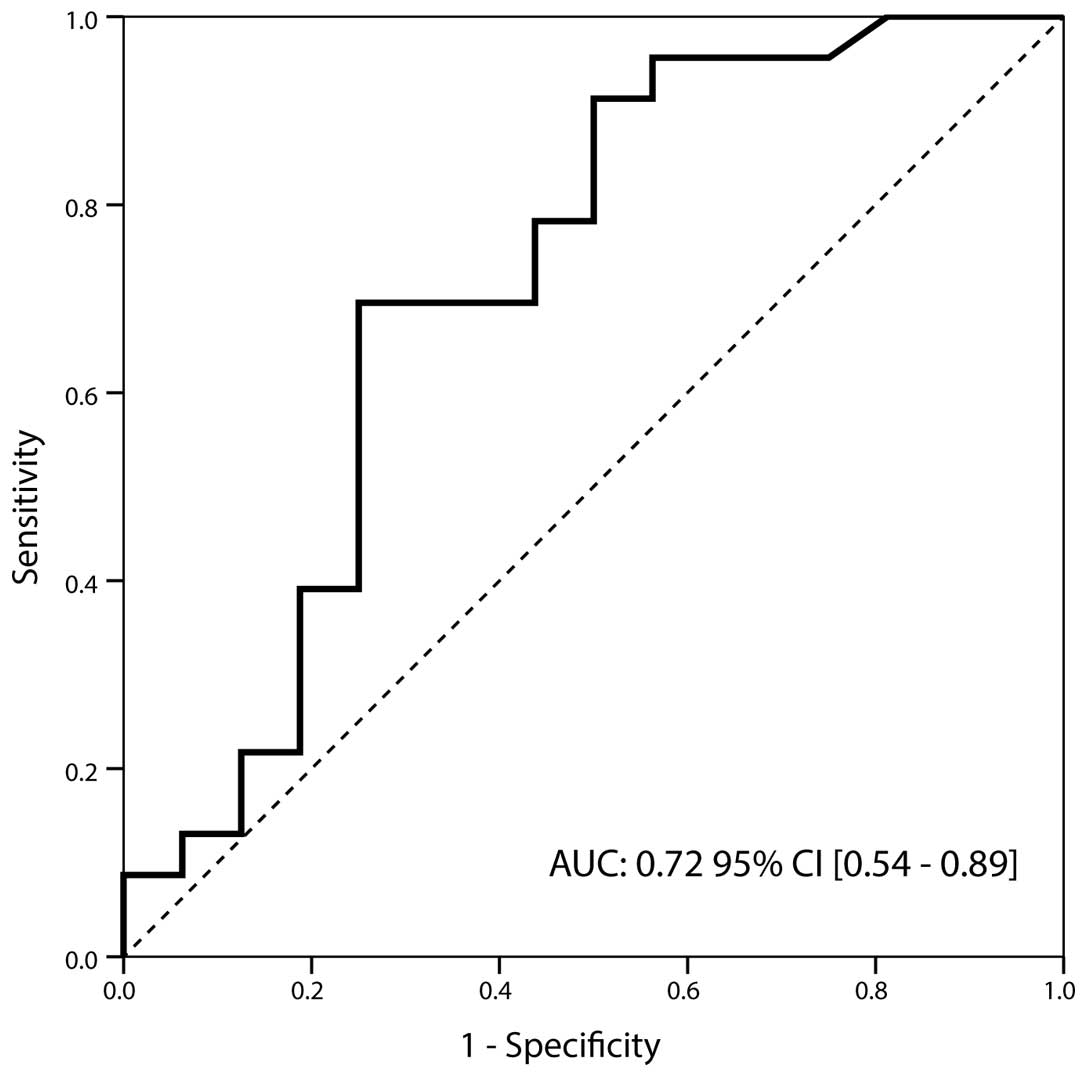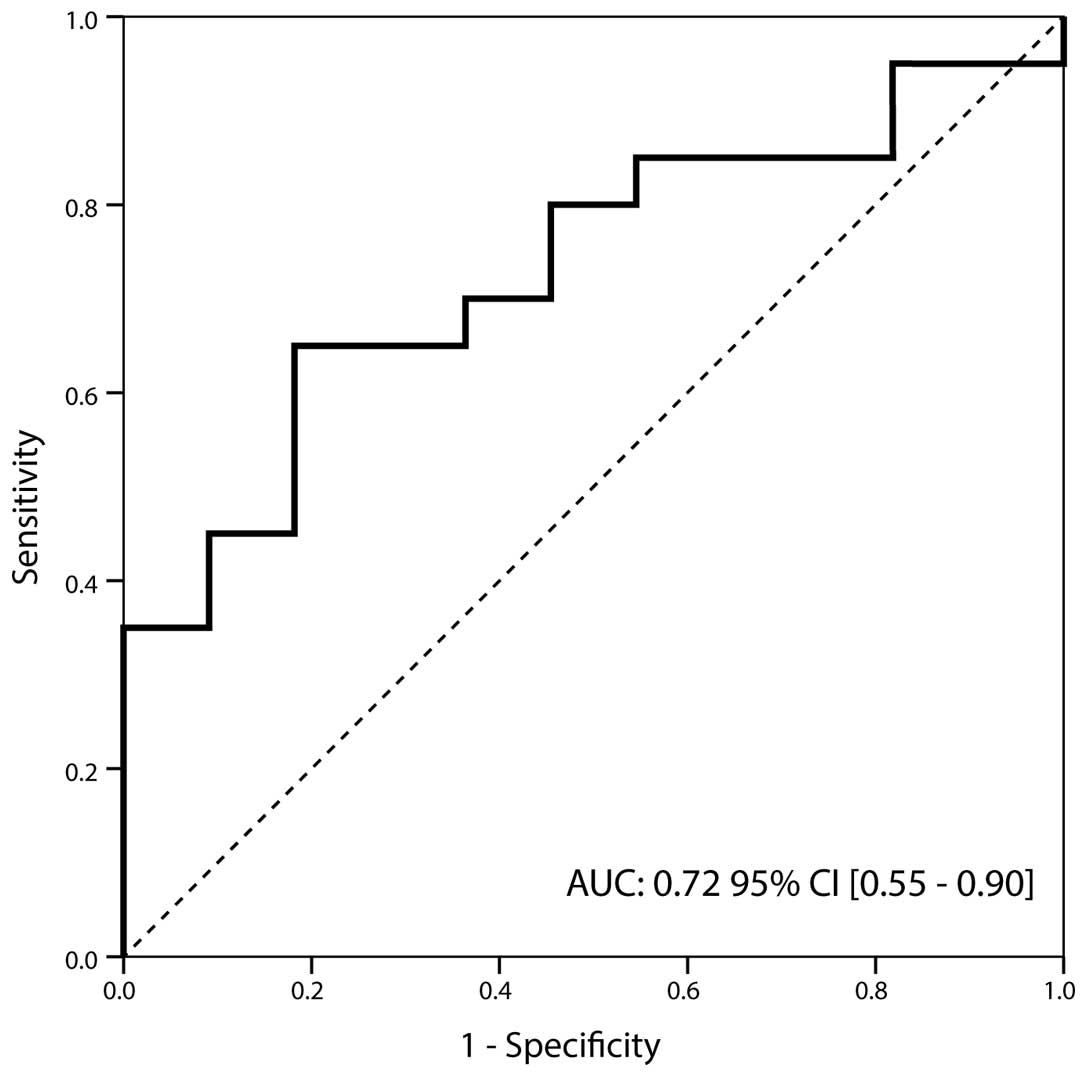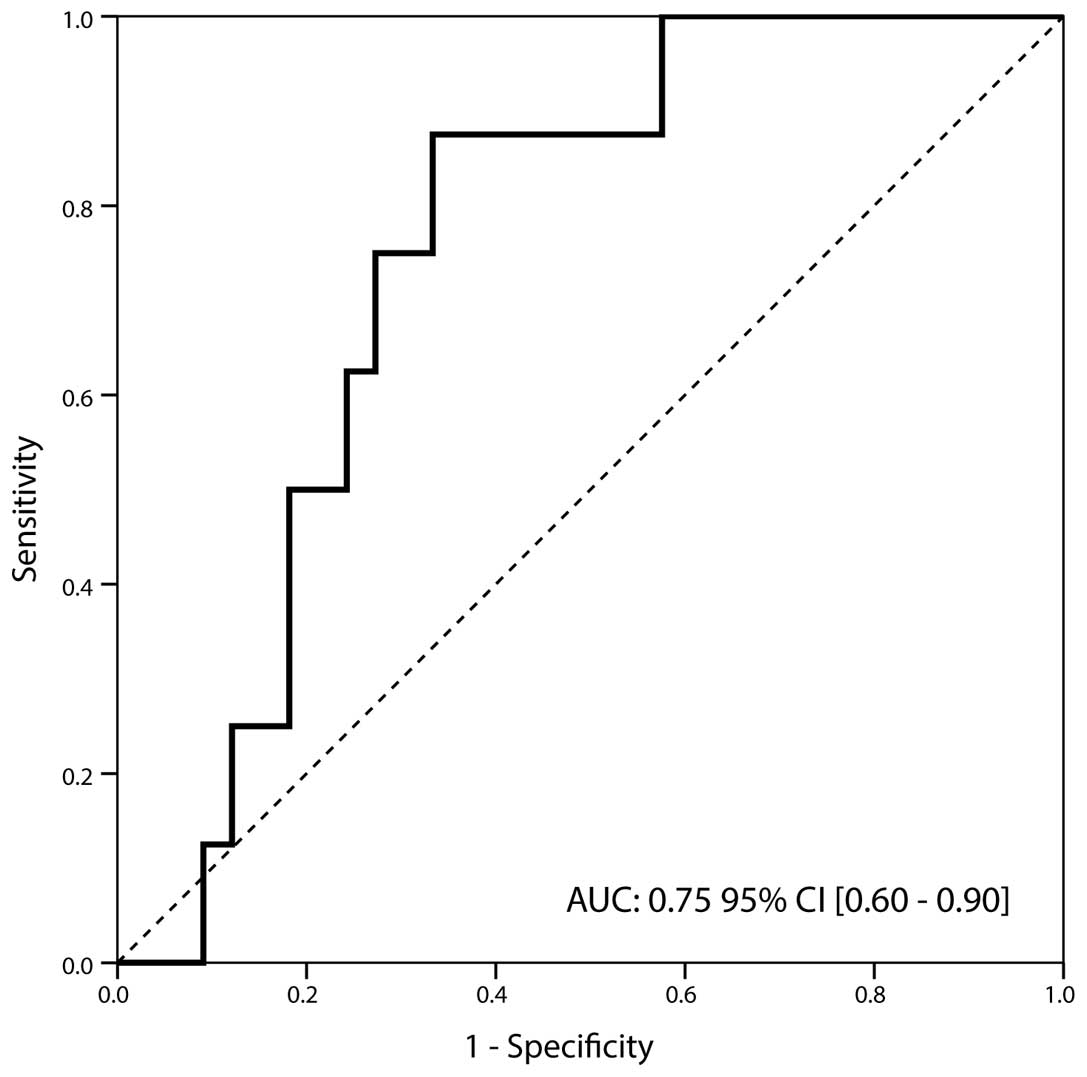|
1
|
Ferlay J, Shin HR, Bray F, Forman D,
Mathers C and Parkin DM: GLOBOCAN 2008, Cancer incidence and
mortality worldwide: IARC CancerBase No. 10. Lyon, France.
International Agency for Research on Cancer. 2010.PubMed/NCBI
|
|
2
|
Freedman ND, Silverman DT, Hollenbeck AR,
Schatzkin A and Abnet CC: Association between smoking and risk of
bladder cancer among men and women. JAMA. 306:737–745. 2011.
View Article : Google Scholar : PubMed/NCBI
|
|
3
|
Burger M, Catto JW, Dalbagni G, Grossman
HB, Herr H, Karakiewicz P, Kassouf W, Kiemeney LA, La Vecchia C,
Shariat S and Lotan Y: Epidemiology and risk factors of urothelial
bladder cancer. Eur Urol. 63:234–241. 2013. View Article : Google Scholar : PubMed/NCBI
|
|
4
|
Wu XR: Urothelial tumorigenesis: A tale of
divergent pathways. Nat Rev Cancer. 5:713–725. 2005. View Article : Google Scholar : PubMed/NCBI
|
|
5
|
Montie JE, Bahnson RR, Cohen SM, Drucker
B, Eisenberger MA, El-Galley R, Herr HW, Hudes GR, Kuzel TM, Lange
PH, et al: National Comprehensive Cancer Network: Bladder
cancer. Clinical practice guidelines in oncology. J Natl Compr Canc
Netw. 1:19–34. 2005.
|
|
6
|
Carlo A, Terracciano D, Mariano A, Oliva
A, D'Armiento M and Macchia V: Role of cytokeratins, nuclear matrix
proteins, Lewis antigen and epidermal growth factor receptor in
human bladder tumors. Int J Oncol. 23:757–762. 2003.PubMed/NCBI
|
|
7
|
Vrooman OP and Witjes JA: Urinary marker
in bladder cancer. Eur Urol. 53:909–916. 2008. View Article : Google Scholar : PubMed/NCBI
|
|
8
|
VanTilborg AA, Bangma CH and Zwarthoff EC:
Bladder cancer biomarkers and their role in surveillance and
screening. Int J Urol. 16:23–30. 2009. View Article : Google Scholar : PubMed/NCBI
|
|
9
|
Shariat SF, Passoni N, Bagrodia A,
Rachakonda V, Xylinas E, Robinson B, Kapur P, Sagalowsky AI and
Lotan Y: Prospective evaluation of a preoperative biomarker panel
for prediction of upstaging at radical cystectomy. BJU Int.
113:70–76. 2014. View Article : Google Scholar : PubMed/NCBI
|
|
10
|
Brinckerhoff CE and Matrisian LM: Matrix
metalloproteinases: A tail of a frog that became a prince. Nat Rev
Mol Cell Biol. 3:207–214. 2002. View
Article : Google Scholar : PubMed/NCBI
|
|
11
|
DiCarlo A, Mariano A, Terracciano D,
Mazzarella C, Galzerano S, Cicalese M, Cecere C and Macchia V:
Gelatinolytic activities (matrix metalloproteinase-2 and-9) and
soluble extracellular domain of Her-2/neu in pleural effusions.
Oncol Rep. 18:425–431. 2007.PubMed/NCBI
|
|
12
|
Nagase H, Visse R and Murphy G: Structure
and function of matrix metalloproteinases and TIMPs. Cardiovasc
Res. 69:562–573. 2006. View Article : Google Scholar : PubMed/NCBI
|
|
13
|
DiCarlo A, Terracciano D, Mariano A and
Macchia V: Urinary gelatinase activities (matrix metalloproteinases
2 and 9) in human bladder tumors. Oncol Rep. 15:1321–1326.
2006.PubMed/NCBI
|
|
14
|
Roy R, Louis G, Loughlin KR, Wiederschain
D, Kilroy SM, Lamb CC, Zurakowski D and Moses MA: Tumor-specific
urinary matrix metalloproteinase fingerprinting: Identification of
high molecular weight urinary matrix metalloproteinase species.
Clin Cancer Res. 14:6610–6617. 2008. View Article : Google Scholar : PubMed/NCBI
|
|
15
|
Chakrabotory S, Kaur S, Guha S and Batra
SK: The multifaceted roles of neutrophil gelatinase associated
lipocalin (NGAL) in inflammation and cancer. Biochem Biophys Acta.
1826:129–169. 2012.PubMed/NCBI
|
|
16
|
DiCarlo A: Evaluation of neutrophil
gelatinase-associated lipocalin (NGAL), matrix metalloproteinase-9
(MMP-9) and their complex MMP-9/NGAL in sera and urine of patients
with kidney tumors. Oncol Lett. 5:1677–1681. 2013.PubMed/NCBI
|
|
17
|
Volpe V, Raia Z, Sanguigno L, Somma D,
Mastrovito P, Moscato F, Mellone S, Leonardi A and Pacifico F: NGAL
controls the metastatic potential of anaplastic thyroid carcinoma
cells. J Endocrinol Metab. 98:228–235. 2013. View Article : Google Scholar
|
|
18
|
Bouchet S and Bauvois B: Neutrophil
gelatinase-associated lipocalin (NGAL), pro-matrix
metalloproteinase-9 (pro-MMP-9) and their complex Pro-MMP-9/NGAL in
leukemias. Cancers (Basel). 6:796–812. 2014. View Article : Google Scholar : PubMed/NCBI
|
|
19
|
Hoboken NJ: Urological tumoursTNM
Classification of Malignant Tumors. Sobin LH, Gospodariwicz M and
Wittekind C: 7th. Wiley-Blackwell; London: pp. 262–265. 2009
|
|
20
|
Shariat SF, Palapattu GS, Karakiewicz PI,
Roger CG, Vazina A, Bastian PJ, Schoenberg MP, Lerner SP,
Sagalowsky AI and Lotan Y: Discrepancy between clinical and
pathological stage: Impact on prognosis after radical cystectomy.
Eur Urol. 51:137–149. 2007. View Article : Google Scholar : PubMed/NCBI
|
|
21
|
Szarvas T, vom Dorp F, Ergün S and Rübben
H: Matrix metalloproteinases and their clinical relevance in
urinary bladder cancer. Nat Rev Urol. 8:241–254. 2011. View Article : Google Scholar : PubMed/NCBI
|
|
22
|
Gomez DE, Alonso DF, Yoshiji H and
Thorgeirsson UP: Tissue inhibitors of metalloproteinases:
Structure, regulation and biological functions. Eur J Cell Biol.
74:111–122. 1997.PubMed/NCBI
|
|
23
|
Hayakawa T: Tissue inhibitors of
metalloproteinases and their cell growth-promoting activity. Cell
Struct Funct. 19:109–114. 1994. View Article : Google Scholar : PubMed/NCBI
|
|
24
|
Miyata Y, Kanda S, Nomata K, Hayashida Y
and Kanetake H: Expression of metalloproteinase-2,
metalloproteinase-9 and tissue inhibitor of metalloproteinase-1 in
transitional cell carcinoma of upper urinary tract: Correlation
with tumor stage and survival. Urology. 63:602–608. 2004.
View Article : Google Scholar : PubMed/NCBI
|
|
25
|
Durkan GC, Nutt JE, Rajjayabun PH, Neal
DE, Lunec J and Mellon JK: Prognostic significance of matrix
metalloproteinase-1 and tissue inhibitor of metalloproteinase-1 in
voided urine samples from patients with transitional cell carcinoma
of the bladder. Clinical Cancer Res. 7:3450–3456. 2001.
|
|
26
|
Monier F, Mollier S, Guillot M, Rambeaud
JJ, Morel F and Zaoui P: Urinary release of 72 and 92 kDa
gelatinases, TIMPs, N-GAL and conventional prognostic factors in
urothelial carcinomas. Eur Urol. 42:356–363. 2002. View Article : Google Scholar : PubMed/NCBI
|
|
27
|
Candido S, Maestro R, Polesel J, Catania
A, Maira F, Signorelli SS, McCubrey JA and Libra M: Role of
neutrophil gelatinase-associated lipocalin (NGAL) in human cancer.
Oncotarget. 5:1576–1594. 2014.PubMed/NCBI
|

















